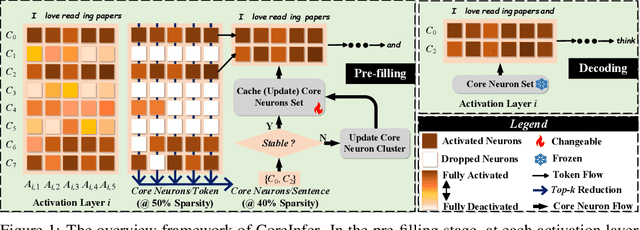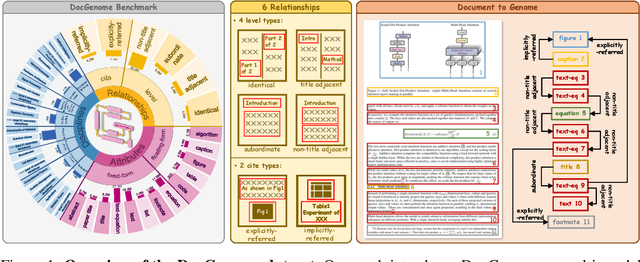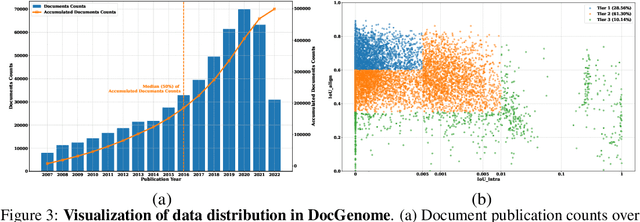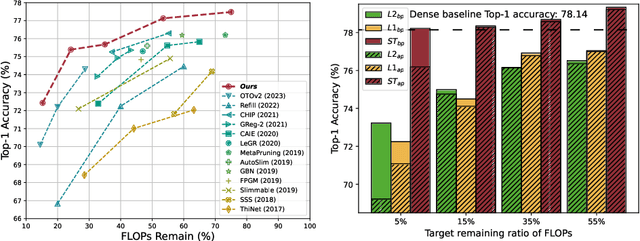Hancheng Ye
SADA: Stability-guided Adaptive Diffusion Acceleration
Jul 23, 2025Abstract:Diffusion models have achieved remarkable success in generative tasks but suffer from high computational costs due to their iterative sampling process and quadratic attention costs. Existing training-free acceleration strategies that reduce per-step computation cost, while effectively reducing sampling time, demonstrate low faithfulness compared to the original baseline. We hypothesize that this fidelity gap arises because (a) different prompts correspond to varying denoising trajectory, and (b) such methods do not consider the underlying ODE formulation and its numerical solution. In this paper, we propose Stability-guided Adaptive Diffusion Acceleration (SADA), a novel paradigm that unifies step-wise and token-wise sparsity decisions via a single stability criterion to accelerate sampling of ODE-based generative models (Diffusion and Flow-matching). For (a), SADA adaptively allocates sparsity based on the sampling trajectory. For (b), SADA introduces principled approximation schemes that leverage the precise gradient information from the numerical ODE solver. Comprehensive evaluations on SD-2, SDXL, and Flux using both EDM and DPM++ solvers reveal consistent $\ge 1.8\times$ speedups with minimal fidelity degradation (LPIPS $\leq 0.10$ and FID $\leq 4.5$) compared to unmodified baselines, significantly outperforming prior methods. Moreover, SADA adapts seamlessly to other pipelines and modalities: It accelerates ControlNet without any modifications and speeds up MusicLDM by $1.8\times$ with $\sim 0.01$ spectrogram LPIPS.
CoreMatching: A Co-adaptive Sparse Inference Framework with Token and Neuron Pruning for Comprehensive Acceleration of Vision-Language Models
May 25, 2025Abstract:Vision-Language Models (VLMs) excel across diverse tasks but suffer from high inference costs in time and memory. Token sparsity mitigates inefficiencies in token usage, while neuron sparsity reduces high-dimensional computations, both offering promising solutions to enhance efficiency. Recently, these two sparsity paradigms have evolved largely in parallel, fostering the prevailing assumption that they function independently. However, a fundamental yet underexplored question remains: Do they truly operate in isolation, or is there a deeper underlying interplay that has yet to be uncovered? In this paper, we conduct the first comprehensive investigation into this question. By introducing and analyzing the matching mechanism between Core Neurons and Core Tokens, we found that key neurons and tokens for inference mutually influence and reinforce each other. Building on this insight, we propose CoreMatching, a co-adaptive sparse inference framework, which leverages the synergy between token and neuron sparsity to enhance inference efficiency. Through theoretical analysis and efficiency evaluations, we demonstrate that the proposed method surpasses state-of-the-art baselines on ten image understanding tasks and three hardware devices. Notably, on the NVIDIA Titan Xp, it achieved 5x FLOPs reduction and a 10x overall speedup. Code is released at https://github.com/wangqinsi1/2025-ICML-CoreMatching/tree/main.
HippoMM: Hippocampal-inspired Multimodal Memory for Long Audiovisual Event Understanding
Apr 14, 2025Abstract:Comprehending extended audiovisual experiences remains a fundamental challenge for computational systems. Current approaches struggle with temporal integration and cross-modal associations that humans accomplish effortlessly through hippocampal-cortical networks. We introduce HippoMM, a biologically-inspired architecture that transforms hippocampal mechanisms into computational advantages for multimodal understanding. HippoMM implements three key innovations: (i) hippocampus-inspired pattern separation and completion specifically designed for continuous audiovisual streams, (ii) short-to-long term memory consolidation that transforms perceptual details into semantic abstractions, and (iii) cross-modal associative retrieval pathways enabling modality-crossing queries. Unlike existing retrieval systems with static indexing schemes, HippoMM dynamically forms integrated episodic representations through adaptive temporal segmentation and dual-process memory encoding. Evaluations on our challenging HippoVlog benchmark demonstrate that HippoMM significantly outperforms state-of-the-art approaches (78.2% vs. 64.2% accuracy) while providing substantially faster response times (20.4s vs. 112.5s). Our results demonstrate that translating neuroscientific memory principles into computational architectures provides a promising foundation for next-generation multimodal understanding systems. The code and benchmark dataset are publicly available at https://github.com/linyueqian/HippoMM.
GeoX: Geometric Problem Solving Through Unified Formalized Vision-Language Pre-training
Dec 16, 2024



Abstract:Despite their proficiency in general tasks, Multi-modal Large Language Models (MLLMs) struggle with automatic Geometry Problem Solving (GPS), which demands understanding diagrams, interpreting symbols, and performing complex reasoning. This limitation arises from their pre-training on natural images and texts, along with the lack of automated verification in the problem-solving process. Besides, current geometric specialists are limited by their task-specific designs, making them less effective for broader geometric problems. To this end, we present GeoX, a multi-modal large model focusing on geometric understanding and reasoning tasks. Given the significant differences between geometric diagram-symbol and natural image-text, we introduce unimodal pre-training to develop a diagram encoder and symbol decoder, enhancing the understanding of geometric images and corpora. Furthermore, we introduce geometry-language alignment, an effective pre-training paradigm that bridges the modality gap between unimodal geometric experts. We propose a Generator-And-Sampler Transformer (GS-Former) to generate discriminative queries and eliminate uninformative representations from unevenly distributed geometric signals. Finally, GeoX benefits from visual instruction tuning, empowering it to take geometric images and questions as input and generate verifiable solutions. Experiments show that GeoX outperforms both generalists and geometric specialists on publicly recognized benchmarks, such as GeoQA, UniGeo, Geometry3K, and PGPS9k.
CoreInfer: Accelerating Large Language Model Inference with Semantics-Inspired Adaptive Sparse Activation
Oct 23, 2024



Abstract:Large language models (LLMs) with billions of parameters have sparked a new wave of exciting AI applications. However, their high computational costs and memory demands during inference pose significant challenges. Adaptive sparse activation inference, which activates only a small number of neurons for each token, offers a novel way to accelerate model inference without degrading performance, showing great potential for resource-constrained hardware devices. Nevertheless, existing methods predict activated neurons based on individual tokens with additional MLP, which involve frequent changes in activation maps and resource calls, limiting the acceleration benefits of sparse activation. In this paper, we introduce CoreInfer, an MLP-free adaptive sparse activation inference method based on sentence-level prediction. Specifically, we propose the concept of sentence-wise core neurons, which refers to the subset of neurons most critical for a given sentence, and empirically demonstrate its effectiveness. To determine the core neurons, we explore the correlation between core neurons and the sentence's semantics. Remarkably, we discovered that core neurons exhibit both stability and similarity in relation to the sentence's semantics -- an insight overlooked by previous studies. Building on this finding, we further design two semantic-based methods for predicting core neurons to fit different input scenarios. In CoreInfer, the core neurons are determined during the pre-filling stage and fixed during the encoding stage, enabling zero-cost sparse inference. We evaluated the model generalization and task generalization of CoreInfer across various models and tasks. Notably, on an NVIDIA TITAN XP GPU, CoreInfer achieved a 10.33 times and 2.72 times speedup compared to the Huggingface implementation and PowerInfer, respectively.
Training-Free Adaptive Diffusion with Bounded Difference Approximation Strategy
Oct 13, 2024



Abstract:Diffusion models have recently achieved great success in the synthesis of high-quality images and videos. However, the existing denoising techniques in diffusion models are commonly based on step-by-step noise predictions, which suffers from high computation cost, resulting in a prohibitive latency for interactive applications. In this paper, we propose AdaptiveDiffusion to relieve this bottleneck by adaptively reducing the noise prediction steps during the denoising process. Our method considers the potential of skipping as many noise prediction steps as possible while keeping the final denoised results identical to the original full-step ones. Specifically, the skipping strategy is guided by the third-order latent difference that indicates the stability between timesteps during the denoising process, which benefits the reusing of previous noise prediction results. Extensive experiments on image and video diffusion models demonstrate that our method can significantly speed up the denoising process while generating identical results to the original process, achieving up to an average 2~5x speedup without quality degradation.
DocGenome: An Open Large-scale Scientific Document Benchmark for Training and Testing Multi-modal Large Language Models
Jun 17, 2024



Abstract:Scientific documents record research findings and valuable human knowledge, comprising a vast corpus of high-quality data. Leveraging multi-modality data extracted from these documents and assessing large models' abilities to handle scientific document-oriented tasks is therefore meaningful. Despite promising advancements, large models still perform poorly on multi-page scientific document extraction and understanding tasks, and their capacity to process within-document data formats such as charts and equations remains under-explored. To address these issues, we present DocGenome, a structured document benchmark constructed by annotating 500K scientific documents from 153 disciplines in the arXiv open-access community, using our custom auto-labeling pipeline. DocGenome features four key characteristics: 1) Completeness: It is the first dataset to structure data from all modalities including 13 layout attributes along with their LaTeX source codes. 2) Logicality: It provides 6 logical relationships between different entities within each scientific document. 3) Diversity: It covers various document-oriented tasks, including document classification, visual grounding, document layout detection, document transformation, open-ended single-page QA and multi-page QA. 4) Correctness: It undergoes rigorous quality control checks conducted by a specialized team. We conduct extensive experiments to demonstrate the advantages of DocGenome and objectively evaluate the performance of large models on our benchmark.
Once for Both: Single Stage of Importance and Sparsity Search for Vision Transformer Compression
Mar 23, 2024



Abstract:Recent Vision Transformer Compression (VTC) works mainly follow a two-stage scheme, where the importance score of each model unit is first evaluated or preset in each submodule, followed by the sparsity score evaluation according to the target sparsity constraint. Such a separate evaluation process induces the gap between importance and sparsity score distributions, thus causing high search costs for VTC. In this work, for the first time, we investigate how to integrate the evaluations of importance and sparsity scores into a single stage, searching the optimal subnets in an efficient manner. Specifically, we present OFB, a cost-efficient approach that simultaneously evaluates both importance and sparsity scores, termed Once for Both (OFB), for VTC. First, a bi-mask scheme is developed by entangling the importance score and the differentiable sparsity score to jointly determine the pruning potential (prunability) of each unit. Such a bi-mask search strategy is further used together with a proposed adaptive one-hot loss to realize the progressive-and-efficient search for the most important subnet. Finally, Progressive Masked Image Modeling (PMIM) is proposed to regularize the feature space to be more representative during the search process, which may be degraded by the dimension reduction. Extensive experiments demonstrate that OFB can achieve superior compression performance over state-of-the-art searching-based and pruning-based methods under various Vision Transformer architectures, meanwhile promoting search efficiency significantly, e.g., costing one GPU search day for the compression of DeiT-S on ImageNet-1K.
Enhanced Sparsification via Stimulative Training
Mar 11, 2024



Abstract:Sparsification-based pruning has been an important category in model compression. Existing methods commonly set sparsity-inducing penalty terms to suppress the importance of dropped weights, which is regarded as the suppressed sparsification paradigm. However, this paradigm inactivates the dropped parts of networks causing capacity damage before pruning, thereby leading to performance degradation. To alleviate this issue, we first study and reveal the relative sparsity effect in emerging stimulative training and then propose a structured pruning framework, named STP, based on an enhanced sparsification paradigm which maintains the magnitude of dropped weights and enhances the expressivity of kept weights by self-distillation. Besides, to find an optimal architecture for the pruned network, we propose a multi-dimension architecture space and a knowledge distillation-guided exploration strategy. To reduce the huge capacity gap of distillation, we propose a subnet mutating expansion technique. Extensive experiments on various benchmarks indicate the effectiveness of STP. Specifically, without fine-tuning, our method consistently achieves superior performance at different budgets, especially under extremely aggressive pruning scenarios, e.g., remaining 95.11% Top-1 accuracy (72.43% in 76.15%) while reducing 85% FLOPs for ResNet-50 on ImageNet. Codes will be released soon.
ChartX & ChartVLM: A Versatile Benchmark and Foundation Model for Complicated Chart Reasoning
Feb 19, 2024Abstract:Recently, many versatile Multi-modal Large Language Models (MLLMs) have emerged continuously. However, their capacity to query information depicted in visual charts and engage in reasoning based on the queried contents remains under-explored. In this paper, to comprehensively and rigorously benchmark the ability of the off-the-shelf MLLMs in the chart domain, we construct ChartX, a multi-modal evaluation set covering 18 chart types, 7 chart tasks, 22 disciplinary topics, and high-quality chart data. Besides, we develop ChartVLM to offer a new perspective on handling multi-modal tasks that strongly depend on interpretable patterns, such as reasoning tasks in the field of charts or geometric images. We evaluate the chart-related ability of mainstream MLLMs and our ChartVLM on the proposed ChartX evaluation set. Extensive experiments demonstrate that ChartVLM surpasses both versatile and chart-related large models, achieving results comparable to GPT-4V. We believe that our study can pave the way for further exploration in creating a more comprehensive chart evaluation set and developing more interpretable multi-modal models. Both ChartX and ChartVLM are available at: https://github.com/UniModal4Reasoning/ChartVLM
 Add to Chrome
Add to Chrome Add to Firefox
Add to Firefox Add to Edge
Add to Edge